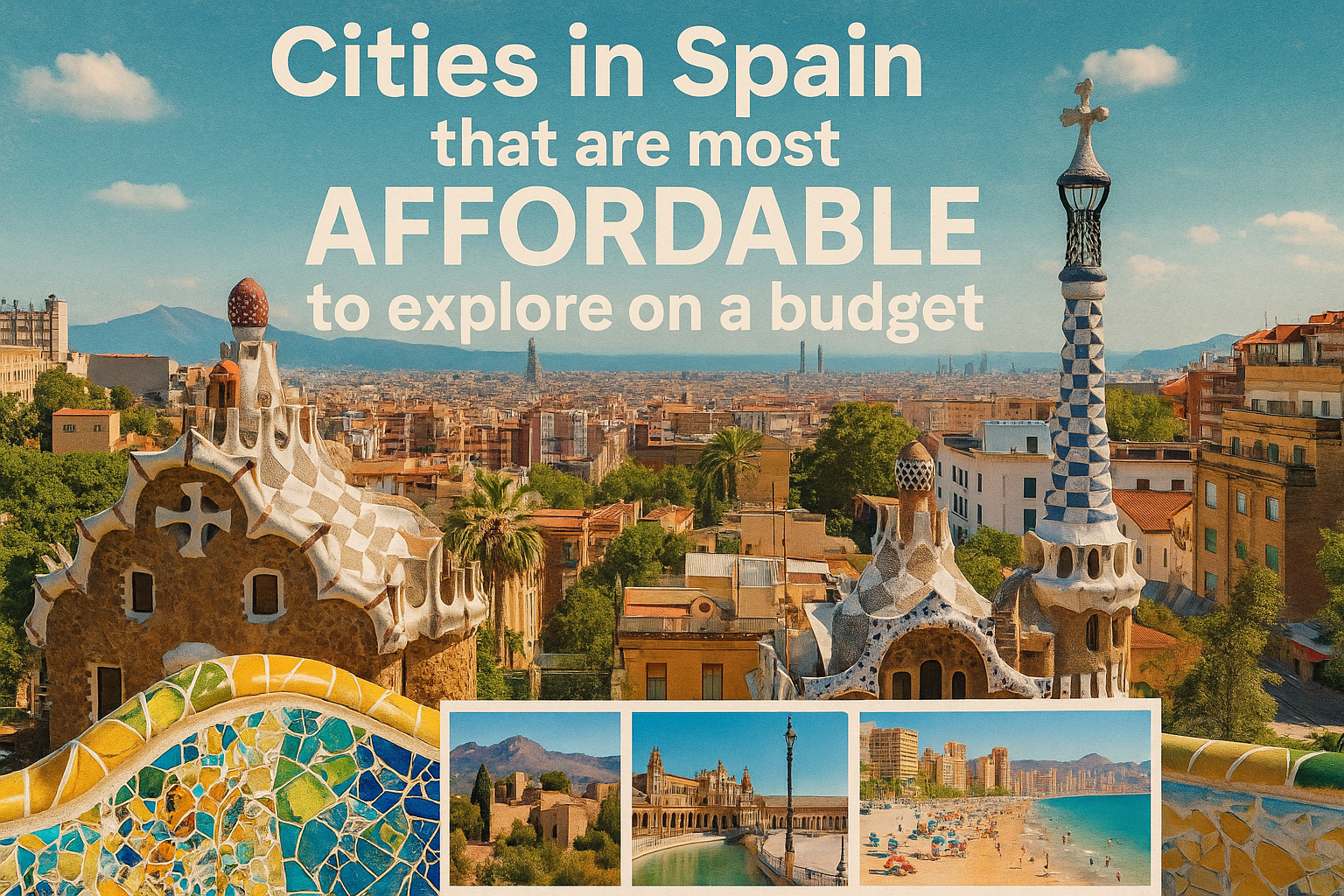Spain’s vibrant cities in Spain are a paradise for budget travelers. With rich history, beautiful architecture, and delicious food, these cities offer excellent value. From free tapas in Granada to lively markets in Valencia, you can enjoy a full cultural experience without breaking the bank. By choosing the right cities in Spain and timing your visit, you can save a lot on accommodation, food, and attractions. Studies show that cities like Las Palmas (Gran Canaria) and Santa Cruz de Tenerife offer holiday costs up to 28–25% below the national average. Even major Andalusian cities like Seville are about 15% cheaper than the Spanish average. In short, smart travelers can explore popular cities in Spain without spending a fortune.

Spending less while enjoying more is the goal. In expensive Europe, Spain’s affordable cities are gems for those watching their wallets. You’ll find cheap hostels or guesthouses (dorm beds often cost only €25–€30 per night), inexpensive dining options (a menu del día lunch for €10–€15), and many free or low-cost sights. Southern and smaller cities tend to be cheaper: for example, Seville and Granada have lower costs than Barcelona or Madrid. In these cities you can walk to key attractions, take free walking tours, and soak up local life without overspending.
Why Explore Cities in Spain on a Budget?
Choosing affordable cities in Spain lets you stretch your euros further. Key factors are low living costs and off-season travel: the country’s winter months (November–February) usually see deep discounts on hotels and tours. The high tourist season (June–August) brings higher prices, while the shoulder and low seasons offer cooler weather plus lower rates. For example, a study notes that “the low season, spanning from November to February…, offers the most affordable travel options”.
- Budget-Friendly Transportation: Spain has an excellent network of buses and trains. Slower regional trains and bus services (like ALSA and FlixBus) can save money between cities. Look for rail passes or bus cards, and avoid taxis when possible. Many cities have cheap monthly public transport passes if you stay several days.
- Affordable Accommodations: Hostels and guesthouses are plentiful. As one traveler notes, “You can expect to spend around €25 for a dorm bed in most spots in Spain”, and even off-season hotel prices can be surprisingly low. City-center guesthouses often run €50–€80/night, and booking in advance can snag even lower rates. In smaller towns or outside tourist centers, lodging drops further.
- Cheap Food and Drink: Eating out can be very reasonable. Many restaurants offer a midday menú del día (set menu) with three courses for about €10–€15. Tapas bars in Granada are famous for giving free snacks with drink orders, and fresh local markets (like Mercado Central in Valencia) let you shop cheaply. Drinks like wine and sangría are generally lower-priced than in Northern Europe.
- Free and Low-Cost Attractions: From park walks to museum days, there are many free activities. Cities often host free festivals, religious processions, or concerts. Walking tours (operated by tip only) are common in tourist cities like Seville and Granada. Entry fees to historic sites are often reduced for students, seniors, or on certain days. For example, some museums in Andalusia have free entry days.
- Regional Price Variations: Northern regions (Basque Country, Catalonia) tend to be more expensive, while the south (Andalusia, Murcia) and islands (Canary Islands) are cheaper. Even within regions, smaller cities and towns are noticeably cheaper than big capitals. Aligning your itinerary with less touristy places can cut costs significantly.
Top Affordable Cities in Spain
Spain has no shortage of wallet-friendly cities. Below are some top picks for budget-conscious travelers, each with its own unique charm and low-cost highlights.
Valencia – Beach, City, and Culture
Valencia, on the eastern coast, blends urban life with a relaxed seaside vibe. It’s Spain’s third-largest city but far cheaper than Madrid or Barcelona. Rent for a one-bedroom apartment in the center averages around €700 per month, indicating relatively low hotel and hostel rates for visitors. The city’s landmarks include the futuristic City of Arts and Sciences and its long sandy beaches. After sightseeing, the Turia Gardens (an old riverbed park) offer free outdoor space for picnics or biking.
Budget Tips: Many markets like Mercado Central or Ruzafa Market sell fresh produce at low prices. Valencia is famous for its paella, and tasting it here won’t cost a fortune – local eateries often serve it affordably. Public bikes (Valenbisi) and efficient tram lines make getting around cheap.
Why It’s Affordable: Valencia’s large size supports competition in tourism services, keeping prices down. A growing expatriate community and moderate cost of living make Valencia a smart base. It’s also a major travel hub (airport and trains), so finding deals on transport is easier.
Seville – Culture in the South
Seville is the flamenco heart of Spain, brimming with Moorish and Andalusian heritage. Here, the cost of living is especially low. Apartments in neighborhoods like Triana or Macarena can be found for under €600/month, meaning visitors will find inexpensive stays. As a travel blogger notes, “Seville… is one of the cheaper parts of Spain”. In fact, one study found Seville holiday costs about 15% below the Spanish average.
Top Attractions: Visit the Alcázar palace and the Seville Cathedral (home of La Giralda tower). Strolling through the Santa Cruz quarter is free and feels like walking through history. Don’t miss free flamenco shows at some local bars or the daily processions in Semana Santa (Holy Week).
Budget Tips: Seville encourages walking – the city center is compact, so you can skip transit costs. The public bus network is cheap if needed. Try neighborhood tapas bars away from tourist plazas to keep meal prices down. Also, take advantage of free admission Sundays at some museums (e.g., Museum of Fine Arts).
Granada – History and Free Tapas
Nestled by the Sierra Nevada mountains, Granada offers a magical mix of nature and history. Its Moorish legacy and vibrant student life make it very affordable. Local tradition gives free tapas with your drink, so meals can be a cultural (and low-cost) event. According to guides, Granada remains “one of the inexpensive cities in Spain,” with a rent for a central apartment around €500/month. Even touristic spots here cost less than in bigger cities – for example, in summer one blogger notes a good hotel room was only €109/night.
Top Attractions: The Alhambra palace is a must-see (book in advance for best price). Wander the Albaicín quarter or visit the San Nicolás viewpoint for free panoramic views. The University of Granada means lots of young people, cafes, and a relaxed vibe.
Budget Tips: Save on transport by buying the Granada Tourist Card, which includes transit and discounts on attractions. Many flamenco bars offer free mini concerts. For dinner, try inexpensive local dishes like plato combinado in student-friendly areas. Visit during winter or off-peak months for lower hotel rates.
Alicante – Sun and Savings on the Costa Blanca
Alicante, on the southeastern coast, is famous for its Mediterranean beaches and castle. It’s a friendly port city where living costs are lower than in larger cities. Average rent for a one-bedroom apartment is around €600, and cheap fresh seafood abounds in local markets. The warm climate means you can enjoy the coast without high summer prices if you travel in spring or fall.
Top Attractions: Explore the hilltop Santa Bárbara Castle (free on Sunday mornings). Lounge on Postiguet Beach or stroll the Explanada promenade. Alicante’s city museum and art galleries often have discounted entry days.
Budget Tips: Use the Luceros tram to visit nearby Playa San Juan cheaply. Many bars serve tapas at happy hour prices. If you love paella or seafood, go to market eateries near the port where locals eat for the best prices.
Las Palmas de Gran Canaria – Island City with Low Costs
Las Palmas, on Gran Canaria (Canary Islands), is a surprisingly affordable beach city. A Rastreator study found that a week in Las Palmas costs 28% less than the Spanish average. The city has a lively downtown, volcanic-sand beaches, and year-round warm weather. Accommodation and dining are cheaper here partly because of lower VAT rates on the islands.
Top Attractions: Relax at Playa de Las Canteras (one of Europe’s top city beaches). Take a free walking tour of the historic Vegueta quarter. Visit Casa de Colón museum for a small fee about the Canary Islands’ maritime history.
Budget Tips: Eating out can be very cheap due to local produce – try tapas at Guirra or Mercado del Puerto. For transport, the inter-island buses are affordable, and flights to Tenerife or mainland Spain are often low-cost.
Santa Cruz de Tenerife – Affordable Island Culture
Santa Cruz is Tenerife’s capital and a gateway to the Canary Islands. It’s known for lively markets and cultural festivals. Like Las Palmas, it’s much cheaper to visit than many mainland cities – about 25% below average for a holiday week. With the ocean on one side and pine forests on the other, you get city life plus nature without high prices.
Top Attractions: The annual Carnaval (in winter) is one of the world’s largest – attending some events is free. Hike or take a cable car up to Mount Teide for epic views (national park fees are modest). The city’s Auditorio is an iconic building; sometimes you can catch free or low-cost concerts.
Budget Tips: Use cheap intercity buses to visit nearby towns on Tenerife (much cheaper than renting a car). Dine in local guachinches (rustic family-run eateries) for traditional dishes at low cost. Enjoy free beach days at Las Teresitas (sand imported from Sahara!).
Other Notable Budget Cities
- Cádiz (Andalusia): An ancient port city almost surrounded by sea, Cádiz offers history (Old Town, cathedrals) and lively markets. Accommodation and seafood here are very affordable, and dinners for two in a central restaurant average around €24, well below other cities. Cádiz has long been considered a budget-friendly Andalucían destination.
- Zaragoza (Aragón): Far from the beach, Zaragoza surprises visitors with cheap prices. It’s been cited as one of Spain’s most affordable cities, with cost of living far lower than the largest cities. It boasts attractions like the Basilica del Pilar and Mudejar architecture with low or no entry fees.
- Murcia: A university city known as “Europe’s orchard,” Murcia is very budget-friendly. It offers historic plazas, terraces, and free events. Many bargains can be found in this less-touristy region.
- Salamanca (Castilla y León): A UNESCO heritage city with affordable stays. Its world-famous Plaza Mayor and university mean you can enjoy beautiful architecture for free and cheap eats from student crowds.
- Córdoba (Andalusia): Home to the Mezquita mosque-cathedral and flower-filled patios, Córdoba is smaller and cheaper than Seville. Many sights (like the Jewish Quarter) are free to wander, and local eateries are inexpensive.
Each of these cities in Spain brings its own flavor and budget-friendly options. They may not be as famous as Madrid or Barcelona, but they offer equally rich experiences at lower prices.

Practical Budget Travel Tips for Spain
Saving money in Spanish cities is easier than you think. Try these practical tips:
- Travel Off-Peak: Plan your trip during late fall, winter, or early spring. Not only are accommodations cheaper, but flights to Spanish cities drop significantly outside the summer peak.
- Use Public Transport: Buy daily or weekly metro/bus passes in big cities like Madrid or Barcelona, or regional transport cards. Many cities offer tourism cards (covering museums and transport). Avoid taxis except when necessary.
- Book Accommodation Wisely: Instead of central tourist hotspots, stay a few blocks out or in residential neighborhoods. These areas have cheaper hostels and B&Bs, and they offer a more local experience. Spanish hostels are typically €25–30 per dorm bed. Booking far in advance or last-minute can both yield deals.
- Eat Like a Local: Search out “menu del día” deals (fixed-price lunches). Shop at mercados (city markets) for fresh food – it’s often 20–40% cheaper than supermarkets. Sample local street food (churros, bocadillos, tapas bars) instead of tourist restaurants. Remember that in many cities, bars outside the tourist center have lower prices.
- Free Attractions and Entertainment: Take advantage of free museum days (often Sundays) and public festivals. In Granada and certain parts of Barcelona or Madrid, major attractions have free hours (check schedules online). Walking tours, parks, street art, and local music performances often cost nothing.
- Daily Budget Planning: A reasonable low-end budget in Spain is about €60–€80 per day (staying in a hostel, eating cheaply, walking). A more comfortable mid-range budget is roughly €120–€180 per day (private room, mix of home-cooked and nice restaurant meals).
- Use Travel Technology: Compare flight and train prices on aggregator sites. Many Spanish cities have ride-share and bike-share schemes (like BiciMAD in Madrid, or Sevilla’s Sevici) that are cheap. Also, free Wi-Fi is common in cafes and squares, so skip unnecessary data roaming.
A simple strategy is to mix one or two splurge experiences (like a paid monument or fancy dinner) with many free/cheap activities. For example, enjoy one lavish paella dinner, but balance it with picnics in parks or tapas nights at budget bars.
FAQ – Budget Travel in Spanish Cities
Q: What are the cheapest cities in Spain to visit?
A: According to travel studies, cities like Las Palmas de Gran Canaria, Santa Cruz de Tenerife, and Seville rank among the cheapest in Spain. Other very affordable cities include Zaragoza, Granada, Alicante, and Murcia. These places have lower accommodation and food costs compared to tourist-heavy cities.
Q: How much money do I need per day in Spain?
A: You can travel on a tight budget of about €60–€80 per day if staying in hostels and eating cheaply. This covers hostel dorms, groceries or casual eats, and local transport. A more comfortable budget of €120–€180 per day allows for private rooms, nice restaurants, some wine, and paid attractions.
Q: When is the cheapest time to visit Spain?
A: The low season (November through February) is generally the most affordable time to travel in Spain. Hotels, flights, and tour prices drop outside the summer months (except around Christmas). Even spring and fall (shoulder seasons) have moderate prices and good weather.
Q: How can I find cheap food and dining in Spain?
A: Look for “menú del día” (set lunch menus) which include multiple courses for around €10–€15. Eat where locals do – neighborhood tapas bars, market stalls, and cafeterias in university areas offer great deals. Many bars in Granada and tapas spots in Madrid’s Lavapiés or Malasaña districts serve inexpensive snacks. Buying fresh produce and bread from markets for a picnic is also very economical.
Q: Are big cities like Madrid or Barcelona worth it on a budget?
A: Madrid and Barcelona are beautiful but generally more expensive. If on a tight budget, you can still visit them by staying outside the tourist core and using hostels or budget hotels. Otherwise, focusing on mid-sized cities (Valencia, Seville, etc.) or islands can save money. According to expat data, Barcelona and Madrid have higher living costs, while cities like Valencia or Granada cost roughly 30–70% less than New York City.
Final Thoughts
Traveling in Spain doesn’t have to be costly. By choosing the right destinations and being smart with your spending, you can enjoy vibrant cities in Spain while keeping to a budget. Each city mentioned here – from Valencia’s beaches to Granada’s Alhambra and the island charm of the Canaries – offers unique experiences that won’t empty your wallet. Remember to travel in off-peak seasons, eat like a local, and take advantage of free cultural events. With some planning and flexibility, you can immerse yourself in Spanish culture and scenery affordably.





